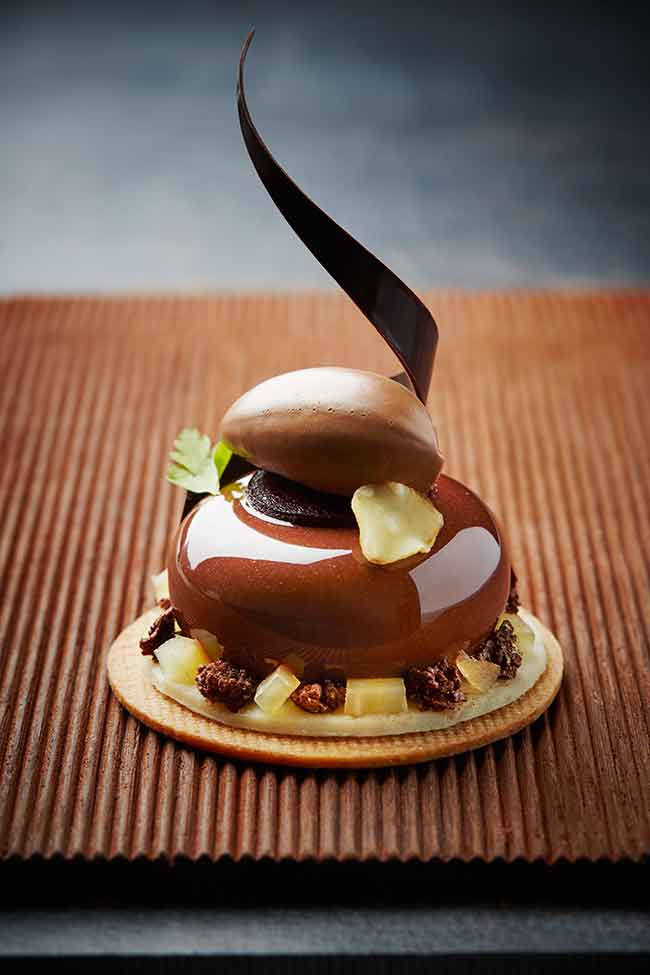
Sweet side of veggies
March 21, 2016
By
Laura Aiken
Meet a pastry chef who was challenged to find the chocolate pairing for parsnip
 Nicolas Dutertre’s Parsnip and Alunga Petits Gateaux marries the flavours of parsnip, blackcurrent and Alunga 41% cacao milk couverture. Photo Credit: Cacao Barry
Nicolas Dutertre’s Parsnip and Alunga Petits Gateaux marries the flavours of parsnip, blackcurrent and Alunga 41% cacao milk couverture. Photo Credit: Cacao BarryNicolas Dutertre has quite the pastry pedigree. He honed his craft with Meilleurs Ouvriers de France at the école Nationale Supérieure de la Pâtisserie Française. Other stints include life as the sous pastry chef at the 5-star palace Hôtel Plaza Athénée before becoming pastry chef at Montreal’s Point G. Now Chef Dutertre is passing down his knowledge as a Callebaut/Cacao Barry pastry chef at the company’s Chocolate Academy training centre in Montreal.
Recently, Cacao Barry challenged some of its chefs to come up with new ways of combining chocolates and vegetables. Dutertre created the Parsnip and Alunga Petits Gateaux. This recipe blends the flavours of parsnip, blackcurrant, and Alunga 41% cacao milk couverture (for the full recipe, visit http://www.cacao-barry.com/en-OC/chocolate-recipe/951/parsnip-alunga-petits-gateaux).
Bakers Journal exchanged emails with Dutertre to learn more about his past, and how he approached the idea of incorporating chocolate with vegetables.
bakers journal / How did you get your start as a pastry chef?
Nicolas Dutertre / I was born and raised in France very close to a Cacao Barry factory. During all those years I was exposed to the finest French gastronomy, in particular in Paris where all the most famous chefs share their passion.
It is thanks to my family that I have become a pastry chef. Since I was six years old, I’ve always wanted to be a pastry chef thanks to my two uncles who were respectively a baker and pastry chef.
BJ / What drew you to working with chocolate?
ND / As a pastry chef, chocolate is part of the daily job. It came naturally to me to explore further the chocolate world when I wanted to increase my knowledge in pastry.
BJ / When did you come to work with the Chocolate Academy?
ND / I started as a technical advisor, pastry chef, with Cacao Barry at the end of 2014 at the Chocolate Academy Center.BJ / Who have been your mentors?
ND / Chef Christophe Michalak has been my mentor. I worked with him at Plaza Athénée in Paris for six years. I admire him for reinventing classic desserts and giving a new breath to the French pastry.BJ / When you were challenged to come up with a chocolate product that incorporated a vegetable, what were your first thoughts?
ND / “What a crazy idea” (smile). After thinking about it, I thought it would be very interesting to have the opportunity to think out of the box in creating a unique recipe.
BJ / What are some of the challenges of incorporating vegetables into chocolate?
ND / I was challenged in which way to work the parsnip. I made several trials to choose which form I would use it. I finally presented it as a cream and candied fruit. I was also challenged on how to associate it best with chocolate. Indeed, the flavour association of the vegetable with the chocolate, and finding the right chocolate to sublimate the vegetable’s flavour without having the chocolate taking all the taste are challenges.
BJ / What vegetables have the flavours that you think pair particularly well with various chocolates?
ND / Red pepper pairs greatly with dark chocolate as it is slightly acidic and sweet. It reveals the aromatic notes of a dark chocolate.
Parsnip pairs perfectly with milk chocolate as there is a hazelnut note in the parsnip which pairs perfectly with a milk chocolate, and especially Alunga.
Beetroot pairs very well with white chocolate as it has a subtle taste and the white chocolate doesn’t dominate the beetroot taste as would a dark or milk chocolate.
BJ / How does texture play a role in your considerations when thinking about how to combine different foods with chocolate?
ND / The texture plays an essential role to have a balance in your dessert. You always need a crunchy texture + a cream or mousse + a refreshing texture such as fruits confit or couli.
BJ / Why did you choose to make the recipe you did?
ND / The parsnip was a great vegetable to work with as it has some hazelnut notes. It is a root vegetable that was long cultivated in North America and is coming back on the menu of the most famous restaurants. I also wanted to take a chance to work with it as I discovered its taste here in Canada, so wanted to use something linked to my new home country.
I created a boutique type dessert and wanted to leave a warm feeling with the people who would taste it. I wanted them to be happy having eaten a vegetable in a dessert and be pleasantly surprised.
BJ / Where do you draw inspiration from when coming up with a new recipe?
ND / I read a lot of pastry books written by all pastry chefs, as most of the time we do not create a new recipe from scratch, but we usually take the base of a recipe and reinvent the dessert to personalize it.
BJ / What other ideas are you exploring in working with plants and chocolate?
ND / I use more aromatic herbs with chocolate (basil, rosemary, mint, coriander) to exhaust the taste of my recipes. Milk chocolate with coriander and praline and white chocolate with a basil ganache are great pairings!
Print this page


Leave a Reply